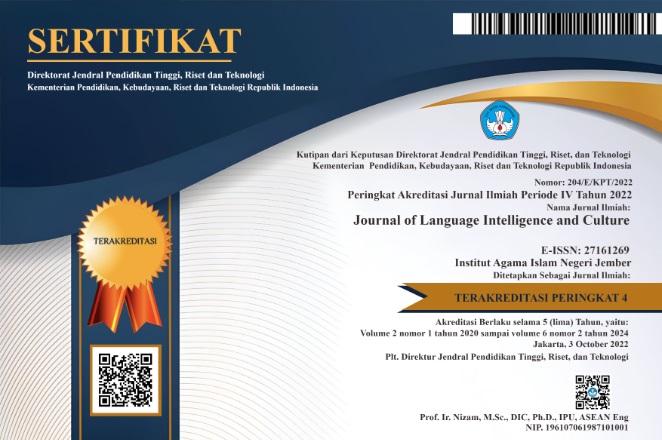Analyzing Undergraduate Students’ Errors in Writing Descriptive Text
DOI:
https://doi.org/10.35719/jlic.v4i2.112Keywords:
error analysis, descriptive text, present tenseAbstract
This study aimed to identify the students’ errors and find the most errors students made. This study used qualitative approach having descriptive approach the research method. The sample were 35 college students in the University at the first semester in English class which selected purposively. The data was collected through the writing test. It is used to identify the type of errors students’ made and the highest errors students’ made in writing descriptive text by using simple present tense. The writing test is conducted two times. After those, the data were analyzed and found the result. The result showed that there were 510 errors found in students’ works, consisting of omission of “be”, inappropriate use of “be”, superfluous of be, subject-verb agreement, wrong form of have/has, wrong form of negative sentence, inappropriate use of pronoun and wrong form of modal auxiliary. The highest number of errors was subject-verb agreement at the first rank with 138 errors or 27% and omission “be” after subject at the second rank with 125 errors or 22.5% and the lowest numbers of error were inappropriate use of pronoun and inappropriate form of negative sentence with 11 error or 2.2 %. Based on the result, it can be found that students have difficulties in writing descriptive text by using simple present tense which influenced of interlanguage transfer and intralingual transfer.
References
Andriyan, (2015). An Error Analysis of EFL Students’ English Writing. English Education Journal (EEJ). 6 (4): 515
Anisah, and Roza Veni. (2022). Students Errors of Using Suffix ‘-S’, ‘-ES’ in Writing Simple Present Tense. Journal of Language Intelligence and Culture (JLIC). 4 (1): 85-98
Azar, Betty Schrampfer. (2002). Understanding and Using English Grammar Third Edition. New York: Longman.
Brown, H.D. (2019). Principles of Language Learning and Teaching. London: Addison Wesley Longman
Chelli, S. (2013). Interlingual and Intralingual Errors in the Use of Proposition and Articles. JSPUI. 2(1)
Corder, S. P. (1991). The Significant of Learner’s Errors. Edinburgh: University of Edinburgh
Corder, S.P. (2000). Error Aanalysis. London: Longman Publisher
Dulay, H. (1982). Language two. Oxford: Oxford University Press.
Frankel, Jack R. and Norman E. Wallen. (2012). How to Design and Evaluate in Research. New York: The McGraw-Hall
Firmansyah, M. (2020). Students’ Errors in Using Simple Present Tense in Writing Descriptive Paragraph. English Education: Journal on Mathematics Education (JME). 8 (1): 48-57
Fitria, Tira. (2019). Errors in Students’ Writing Composition Simple Present Tense “My Daily Activity”. Journal of English Language Education. 2(1): 47-62
Indriani, S. (2019). Students’ Errors in Using the Simple Present Tense at Polytechnic ATI Padang. Lingua Cultura, 13(3), 217-221.
James, Carl. (1998). Error in Language Learning and Use: Exploring Error Analysis. London: Routledge
Lestari, I. (2020). Error Analysis of Simple Present in Writing Descriptive Text. English Language Teaching and English Linguistics Journal. 5(2): 1-7
Murphy, R. (2003). English Grammar in Use. New York: Cambridge University Press.
Pohan, A. (2017). Students’ Errors on Writing: An Analysis Studies at Junior High School. DIMENSI. 6(2): 341-348
Richard, J.C. (1974). Error Analysis: Perspective on Second Language Acquisition. London: Longman Group Ltd
Siregar, H. (2020). Students’ Error in Using Simple Present Tense. Professional Journal of English Education (PROJECT). 3 (3): 379-383
Siswoyo, S. (2016). Students’ Error In Using Simple Present Tense Mastery. English Education: Jurnal Tadris Bahasa Inggris, 9(2), 461-479.
Sumarti, S. (2020). Writing Errors in Students’ Foreign Language Acquisition. Jurnal Pendidikan Bahasa Asing dan Sastra. 4 (2):215-222
Downloads
Published
How to Cite
Issue
Section
License
Copyright (c) 2022 Noor Aisyah, Universitas Moch. Sroedji

This work is licensed under a Creative Commons Attribution-ShareAlike 4.0 International License.













